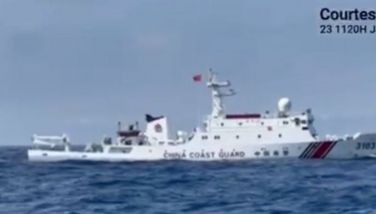Positioning the Philippines for eventual war?

Two months ago, as the Supreme Court deliberated on the two petitions urging it to declare the Phl-US Enhanced Defense Cooperation Agreement unconstitutional, I wrote about former US Senator Mike Gravel’s warning, via his petition-in-intervention filed through Filipino lawyers, that the EDCA could lead to war.
The arrangement, according to the American senator, was meant to provide the US a “strategic launching pad in its supposed campaign to contain rising China.” It could aggravate tensions in Asia-Pacific, he argued, and bring into reality the growing fears of war over the South China Sea. He invoked the “Thucydides trap” – referring to the attendant danger of war when a rising power (China) rivals a ruling power (US) – as evidenced by 12 wars recorded in world history.
America, Gravel said, is “skirting ever so close to the Thucydides trap,” its political leadership unable to reverse the trajectory. However, the SC rejected his petition, saying he had no legal standing to intervene in the case. Voting 10-4-1, the tribunal declared the EDCA constitutional.
Now, two recent reports emanating from Washington appear to buttress Gravel’s warning.
One report, by the British Guardian, is about a study by the Center for Strategic and International Studies, commissioned by the Pentagon. It urges America to flex its military muscle in Asia-Pacific – in light of its finding that military power in Asia is “shifting against the United States.” The study will be the subject of a public hearing by the Senate armed services committee, headed by Republican Sen. John McCain.
Titled “Asia-Pacific Rebalance 2025: Capability, Presence, and Partnerships,” the study outlines four elements for US military buildup. These are the following:
1. Continuing to align Asian strategy within the US government and with allies and partners;
2. Accelerating efforts to strengthen capability, capacity, resilience, and interoperability between them;
3. Sustaining and expanding the US military presence in Asia-Pacific;
4. Innovating in order to plug “critical capability gaps” in two areas: 1) defending against emerging risks to US forces, such as growing ballistic missile risks to American ships and forward bases (the planned “agreed locations” in the Philippines for US military facilities under EDCA would constitute forward bases); and 2) gaining an “asymmetric, cost-imposing counter” to potential regional competition.
Among the CSIS study’s specific recommendations for muscle-flexing in Asia-Pacific are to increase surface fleet presence, deploy more nuclear-attack submarines in Guam, continue to diversify air operating locations, bolster regional missile defences, stockpile critical precision munitions, and enhance intelligence, surveillance and reconnaissance cooperation with regional allies.
In all these, one can discern how the Philippines, through the EDCA, is supposed to fit into the scheme of things being plotted by the US “military-industrial complex.”
“Chinese and North Korean actions are routinely challenging the credibility of US security commitments,” the study notes, “and at the current rate of US capability development the balance of military power in the region is shifting” against the dominant superpower. “Robust funding is needed to implement the rebalance,” meaning, more money for war preparations (instead of, say, social programs).
The study recommends “institutionalizing a culture of experimentation.” This entails, among others, “energizing rapid platform evolution,” developing advanced long-range missiles, funding innovative missile defense concepts, fielding additional air combat systems, exploiting America’s “undersea advantage,” and augmenting space, cyber, and electronic warfare capabilities.
If China’s economic, military, and geopolitical influence continue to rise at even a modest pace in the next 10 to 15 years, the study projects, “the world will witness the largest shift in the global distribution of power since the rise of the US in the late 19th and early 20th centuries.” And if within that period China surpasses the US as the world’s largest economy, “it will mark the first time in centuries that the world’s economic leader will be non-English speaking, non-Western, and non-democratic.”
“Of course these are some major ifs,” the study hastens to add, intimating the scenario may change if its recommendations were to be carried out.
The other report, by the International New York Times, pertains to a proposal by the Pentagon and the US Energy Department to modernize America’s current stockpile of nuclear weapons by turning these into smaller arms with lesser nuclear-power yield but more reliable targeting capabilities. The plan has sparked a debate among key military and civilian defense officials and criticisms from scientist groups.
The proponents claim that improving the existing weapons fulfils President Obama’s pledge not to produce new nuclear armaments and still makes their use “less likely because of the threat they can pose.” But the plan’s critics counter that the smaller yields and better targeting “can make the arms more tempting to use – even to use first [in attack], rather than in retaliation.”
Most controversial is the B61 Model 12, the first of five cruise missile nuclear warheads flight-tested last year, as part of a revitalization program estimated to cost $1 trillion over 30 years. It’s described as “small, stealthy, and precise.” Russia has denounced the program as “irresponsible” and “openly provocative” and China is reportedly worried over the nuclear-tipped cruise missile. (China’s strategic deterrence force allegedly includes nuclear and conventional ballistic and cruise missiles.)
Within the US defense establishment, concerns have been raised over the nuke modernization plan. The former director of the Nuclear Weapons Council, Andrew Weber, called it “unaffordable and unneeded.” The Union of Concerned Scientists cites a finding by federal advisory scientists that “simply refurbishing weapons in their existing configurations could keep them in service for decades.” And the Federation of American Scientists warns that the claimed high accuracy and low destructive settings of the new weapons can induce military commanders to use them in an attack, simply because of assurances that the radioactive fallout and collateral damage would be limited.
It’s truly disturbing to contemplate how these developments in strategy and arms modernization could drag us into another US war, once the EDCA is implemented.
* * *
Email: [email protected]
- Latest
- Trending






























